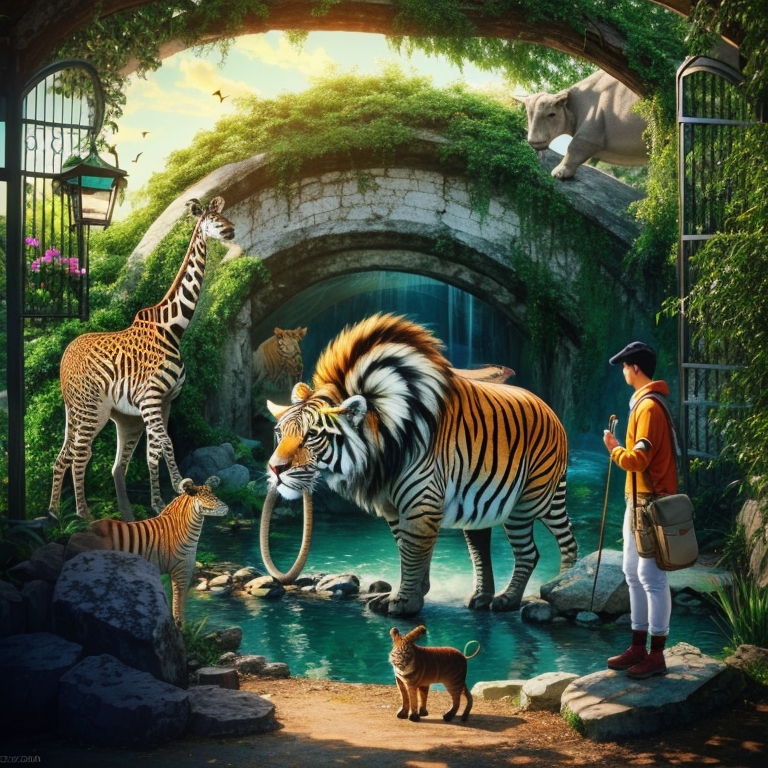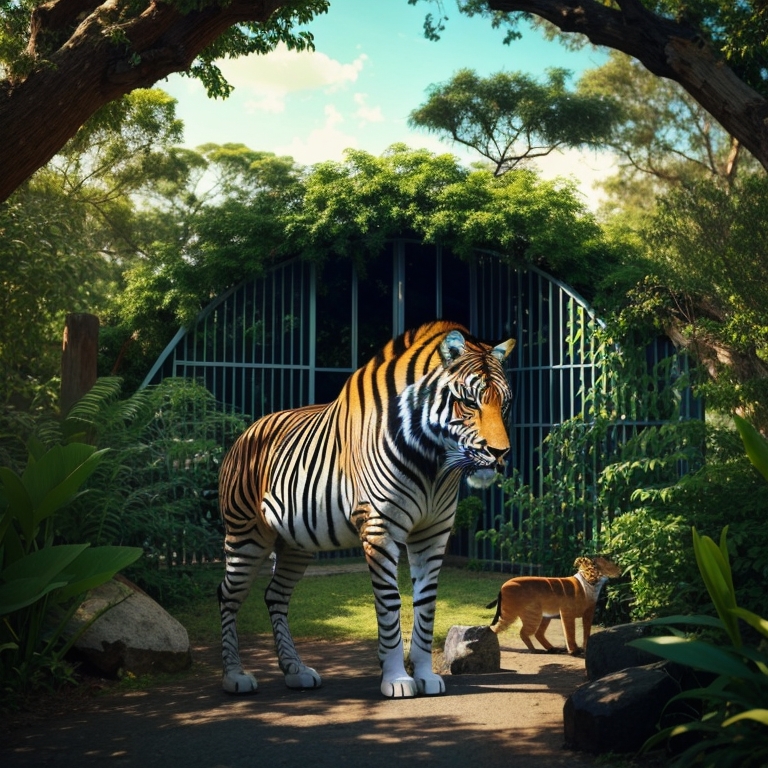
Art of Zoo
Unleashing the Captivating Beauty: Exploring the Art of Zoo Photography
Zoos provide an excellent opportunity for photographers to capture the captivating beauty of wildlife. With a diverse range of animals and stunning natural settings, zoo photography offers endless possibilities for creative expression. In this article, we will delve into the art of zoo photography, exploring techniques, tips, and equipment to help you capture awe-inspiring images of these remarkable creatures.
Introduction: The Fascination with Zoo Photography
Zoo photography offers a unique opportunity to observe and capture the beauty of animals up close. It allows us to appreciate their diverse forms, colors, and behaviors, while also raising awareness about wildlife conservation. Whether you are a beginner or an experienced photographer, exploring the art of zoo photography can be an enriching and rewarding experience.

Essential Equipment for Zoo Photography
To capture stunning images at the zoo, it is essential to have the right equipment. Here are some key tools every zoo photographer should consider:
-
Camera and Lenses
Invest in a DSLR or mirrorless camera with manual settings to have full control over your shots. A versatile zoom lens, such as a 70-200mm, is ideal for capturing animals both near and far. For detailed close-ups, a macro lens can reveal intricate textures and patterns.
-
Tripod or Monopod
A sturdy tripod or monopod can help stabilize your camera, especially when photographing in low-light conditions or using heavy telephoto lenses. It ensures sharpness and minimizes camera shake for crisp images.
-
Polarizing Filter
A polarizing filter can reduce glare and enhance colors, particularly when photographing through glass enclosures or bodies of water. It also helps to darken skies and emphasize cloud formations.
-
Extra Batteries and Memory Cards
Carry spare batteries and memory cards to avoid missing out on precious moments. Zoo visits can be time-consuming, and having backup power and storage ensures uninterrupted photography.
Mastering Composition and Framing
Composition plays a vital role in creating visually appealing zoo photographs. Here are some tips to enhance your composition skills:
-
Rule of Thirds
Divide your frame into thirds using imaginary lines and position your subject along these lines or at their intersections. This technique adds balance and visual interest to your images.
-
Leading Lines
Utilize natural lines, such as fences or tree branches, to guide the viewer’s eye towards your subject. Leading lines create depth and draw attention to the main focal point.
-
Negative Space
Don’t be afraid of including negative space in your compositions. It allows the subject to breathe and adds a sense of scale and tranquility to your images.

Capturing Expressions and Behaviors
One of the joys of zoo photography is capturing the unique expressions and behaviors of animals. Here are some techniques to help you document these fascinating moments:
-
Patience and Observation
Take the time to observe the animals and understand their behavior. This allows you to anticipate interesting actions or interactions and be ready to capture them when they happen.
-
Fast Shutter Speeds
To freeze motion and capture sharp images, use fast shutter speeds. Animals are often on the move, and a quick shutter speed ensures you don’t miss any action or expressions.
-
Eye Contact
Aim to capture eye contact with your subjects as it creates a connection between the viewer and the animal. Center around the eyes and guarantee they are sharp and sufficiently bright.
Overcoming Challenges: Lighting and Crowds
Zoo photography presents unique challenges, such as uneven lighting conditions and crowded spaces. Here’s how you can overcome these obstacles:
-
Golden Hours
Make the most of early mornings or late afternoons when the sunlight is softer and creates warm, golden tones. These hours offer the best lighting conditions for capturing stunning images.
-
Backlighting
Experiment with backlighting to create dramatic silhouettes or add a glow to your subjects. Position yourself so that the light comes from behind the animal, highlighting its outline.
-
Patience and Persistence
To avoid capturing crowds in your images, be patient and wait for the right moment. Move around, change perspectives, and utilize creative angles to frame your shots without obstructions.
Ethical Considerations in Zoo Photography
While photographing animals at the zoo, it is essential to prioritize their welfare and follow ethical guidelines. Here are a few contemplations to remember:
-
Respect Animal Boundaries
Always maintain a safe distance and respect any barriers or enclosures provided by the zoo. This ensures the well-being of the animals and your own safety.
-
Avoid Flash Photography
Flash photography can startle or distress animals. Unless explicitly allowed by the zoo, refrain from using the flash to prevent any harm or discomfort to the animals.
-
Educate and Raise Awareness
Use your zoo photographs as a means to educate others about the importance of wildlife conservation. Share information about the animals and the conservation efforts being undertaken.
Post-Processing Techniques for Stunning Results
Post-processing plays a crucial role in enhancing the visual impact of your zoo photographs. Consider these techniques for stunning results:
-
Adjusting Exposure and Contrast
Fine-tune the exposure and contrast to bring out details and create a balanced look. Use software like Adobe Lightroom or Photoshop to make precise adjustments.
-
Enhancing Colors
Adjust the saturation and vibrancy of the colors to make them pop. Be cautious not to overdo it, as natural-looking colors are more appealing and authentic.
-
Sharpening and Noise Reduction
Apply selective sharpening to bring out the fine details, such as fur or feathers. Reduce noise in low-light images using noise reduction tools to maintain image quality.
Sharing Your Zoo Photography with the World
Once you have captured stunning zoo photographs, it’s time to share them with others. Here are some avenues to showcase your work:
-
Social Media Platforms
Leverage social media platforms like Instagram, Facebook, or Flickr to share your zoo photographs. Engage with the photography community and gain valuable feedback and exposure.
-
Photography Websites and Blogs
Create a portfolio website or start a photography blog to display your best work. Write accompanying articles or stories to provide context and share your experiences.
-
Local Exhibitions and Contests
Participate in local photography exhibitions or contests to showcase your zoo photographs to a broader audience. This can lead to recognition and opportunities for further exposure.
Conclusion
Zoo photography offers a mesmerizing journey into the captivating world of wildlife. By honing your skills, utilizing the right equipment, and respecting ethical considerations, you can unleash your creativity and capture breathtaking images. Remember to always prioritize thewell-being of the animals and use your photography as a tool for education and conservation.
FAQs
- Is it necessary to have expensive camera equipment for zoo photography? While having high-quality equipment can enhance the image quality, you can still capture great photos with more affordable camera gear. The key is to understand your equipment’s capabilities and make the most of them.
- How can I capture unique and different perspectives of the animals at the zoo? Experiment with different angles and compositions. Get low to the ground or find vantage points that offer a different view. Look for reflections, interesting patterns, or interactions between animals to create unique and captivating images.
- Are there any specific settings I should use for zoo photography? It’s essential to shoot in manual mode to have full control over your camera settings. Adjust your aperture to control the depth of field and select an appropriate shutter speed to freeze motion or create motion blur. Keep an eye on your ISO to maintain image quality.
- What are some ethical considerations when photographing animals at the zoo? Always respect the boundaries set by the zoo and prioritize the well-being of the animals. Avoid causing any distress or harm and follow the guidelines provided by the zoo regarding photography. Educate yourself about the conservation efforts and share information to raise awareness.
- How can I make my zoo photographs stand out from the rest? Focus on capturing unique moments, expressions, and behaviors. Pay attention to composition, lighting, and storytelling through your images. Develop your own style and vision, and continuously strive to improve your skills through practice and experimentation.
In conclusion, zoo photography offers a gateway to the captivating world of wildlife. By mastering the art of composition, capturing expressions and behaviors, overcoming challenges, and respecting ethical considerations, you can create awe-inspiring images that not only showcase the beauty of these incredible creatures but also raise awareness about the importance of wildlife conservation. So grab your camera, visit your nearest zoo, and unleash your creativity to capture the mesmerizing allure of zoo photography.



